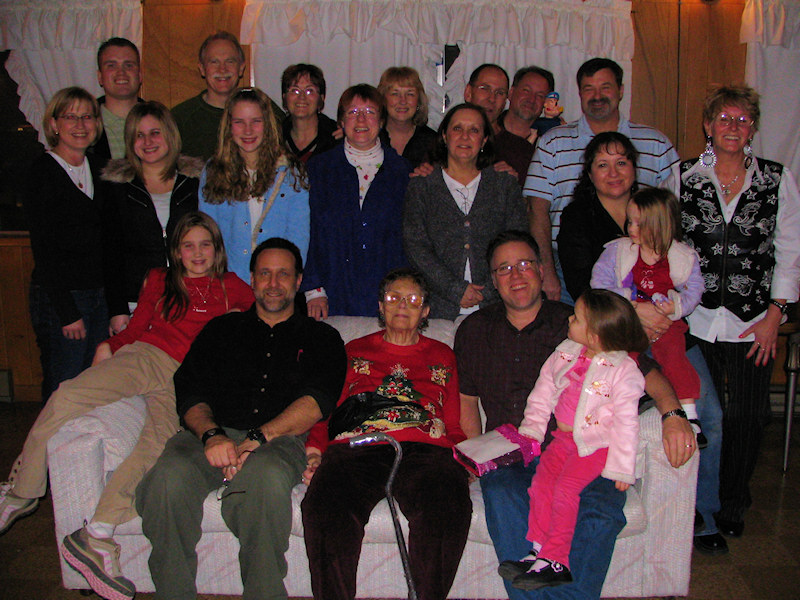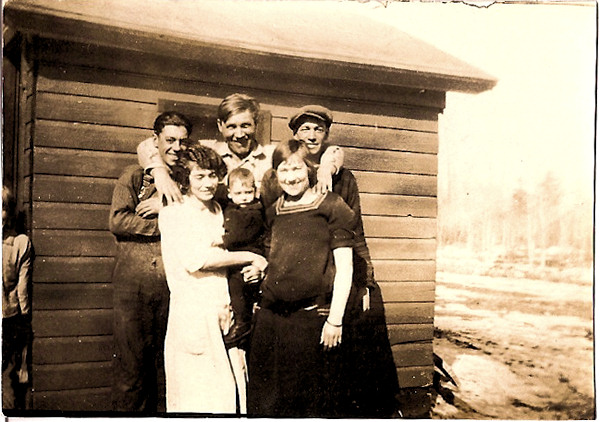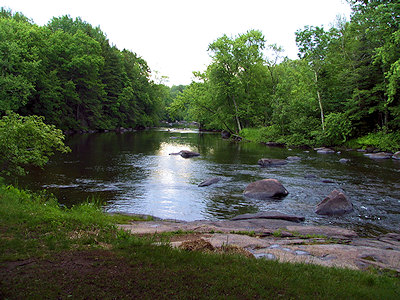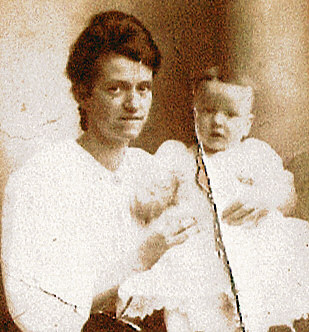The Knapp Family of Taylor Rapids, Wisconsin, lived for a long time in a log cabin they’d built called Ruby Shack that sat along the rail line that stopped about a mile or two east in the former logging camps of Taylor Rapids. There, the empty train car beds would be rapidly filled with fresh cut logs from the surrounding forests, many by the older members of the Knapp family, and hauled back with belching coal smoke to Wausaukee and beyond to be converted to power and telephone poles, boardwalks, furniture, singles, and buildings around the country.
As the logging economy fell, so did the families dependent upon logging in Taylor Rapids and the surrounding areas in Northern Wisconsin. By 1920, the logging train was stopped and the tracks removed, used elsewhere on the lines. A few years later, the railroad ties were removed and the tracks were converted into wagon roads. When the automobile moved into dominance, the county paved the roadway out to the now hunting and fishing wilderness.
The Knapp family journal of 1916-1924 describes a train derailment in Northern Wisconsin in 1917.
I continue to research the trains my ancestors relied upon as part of the logging industry and their daily lives.
I recently found the Master list of Wisconsin Logging Railroads which describes the Wausaukee to Taylor Rapids line’s history with the Wisconsin & Northwestern Railroad as:
This railroad began operation in 1889 as the private road of the Bird & Wells Lumber Company of Wausaukee. Bird & Wells operated in the area just west of Wausaukee. In 1892 B&W sold 2.78 miles of track to the Milwaukee. It was the southmost portion of the MILW branch that ran northwest from Wausaukee through Athelstane and connected with the Dunbar & Wausaukee at Girard Junction. Bird & Wells maintained rights on their former line, and also on the Milwaukee branch to a connection with the Dunbar & Wausaukee.
Several spurs were built off of the south end of the D&W for Bird & Wells logging. Holmes & Son were also active in the Phillipsburg area as well. In 1903 Bird & Wells Lumber became the J. W. Wells Lumber Company. The following year an 18 mile line was constructed westerly from Phillipsburg on the D&W west about 18 miles. Part of this line was constructed on former rights of way from old D&W and Girard Lbr Co spurs.
Wells incorporated the Wisconsin & Northwestern on July 21, 1906 as a common carrier. The common carrier portion of the line connected with the Dunbar & Wausaukee at Phillipsburg about a mile north of its Girard Junction connection with the Milwaukee. W&NW had trackage rights over the D&W and the MILW throughout its lifetime so that log trains could reach the mill.
The W&NW ran almost due west from Phillipsburg ending in east central Forest County. The common carrier portion of the line ended at Taylor Rapids on the Peshtigo River in section 10 of tn 35N r 17E. In 1918 when the Dunbar & Wausaukee was abandoned, the portion of its line between Girard Jct and Phillipsburg became a part of the W&NW. The Wisconsin & Northwestern was abandoned in 1921.
This backs up the family notes that state the old logging train line was abandoned about 1920 and converted to a road a few years later.
The McMillian Library – Wisconsin Logging on Railroad Logging (pdf) talks about the coming together of leading lumbermen investing in the rail system to extend the reach directly out to the vital logging camps, speeding up the process of transporting logs from the timber lands to the mills and beyond. The research document shows excellent photographic examples of what life among the logging railroads was like, including this example of Fosterville, Wisconsin, probably much like Taylor Rapids once looked like before the turn of the century.
Public documents from the State of Wisconsin Railroad Commission reveal court documents dated March 24, 1914, involving the Peshtigo Lumber Company and the Chicago, Milwaukee and St. Paul Railway Company, Wisconsin and Michigan Railway Company, and the Wisconsin Northwestern Railway Company give us an inside historical look at the transportation costs of shipping the logs out of Taylor Rapids. The suit concerned the transportation of thirteen shipments of cedar posts from Taylor Rapids to Peshtigo and a request for a refund on account of illegal and erroneous handling.
The charges in question were based on a rate of 8 1/2 cts. per 100 lb., then in effect from Taylor Rapids to Bagley Jct., plus a charge of $3 per car from Bagley Jct. to Peshtigo. At the time the shipments moved a rate of 6 1/2 cts. per 100 lb. was in effect from Taylor Rapids to Marinette and Menominee, Mich., points beyond Bagley Jct. on the C. M. & St. P. Ry., and this rate has since been put into effect over the same line from Taylor Rapids to Bagley Jct. The C. M. & St. P. Ry. is willing to grand the relief asked.
The charged complained of were unusual and exorbitant. Refund is ordered upon the basis of 6 1/2 cts. per 100 lb. from Taylor Rapids to Bagley Jct., plus $3 per car from the latter point to Peshtigo, which would have been the reasonable charges for the service performed.
We’ve been trying to find more information on the 1916 train derailment near Taylor Rapids, and stumbled upon this report from The Northwestern reporter of a Supreme Court of Wisconsin suit, Ruel v Wisconsin Northwestern Railway Company dated June 12, 1917.
In an action for the death of a railroad conductor thrown from the train while trying to uncouple cards for the purpose of making a flying switch, evidence as to the engineer’s negligence in starting the engine with a sudden movement without waiting for a signal from the conductor after slacking his engine to permit the uncoupling, and whether this was the proximate cause of the conductor’s death, held to make case for the jury.
…Under the federal statute, a railway conductor attempting to uncouple cards for the purpose of making a flying switch did not assume the risk of injury from the engineer’s negligence in operating the engine.
…This is a action by the plaintiff, as administrator of the estate of Joseph Lucia, deceased, to recover damages from the defendant, the Wisconsin Northwestern Railway Company, for the injuries and death of Joseph Lucia, caused by the alleged negligence of the defendant. Joseph Lucia was employed by the defendant as conductor on one of its trains making regular trips from Taylor Rapids to Girard Junction, Wis. The trains were used primarily to haul logs from Taylor Rapids to Menominee, Mich. On January 5, 1916, Joseph Lucia, who at the time of the accident was doing a brakeman’s work, in making a cut for the purpose of making a “flying switch” or dropping some flat cars, which constituted part of the train, onto a side track, fell from the car, receiving injuries which resulted in his death some hours later. At the close of testimony, the circuit court awarded judgement, dismissing the plaintiff’s complaint on the merits.
The case was appealed and in the testimony are more details. The flying switch is described as a movement of the brakeman where he would stand on an iron footrest or stirrup at the bottom of the car and hold onto an iron handhold attached to the side of the car. In this dangerous position if the train were moving, he’d have to reach around the side of the box car with his left hand to grasp the lever place on the flat car and coupled to the box car, making it possible to control the coupling pin between the two cards, “dropping” the car away.
It was the duty of the engineer to not speed up but to slow down, slackening the tension between the two cars, and to keep his eyes on the person attempting the flying switch as to not change speeds in any way until he’d received a signal. In the end, the judgment was reversed and the case went onto a new trial.
At the time of the incident, the train consisted of an engine, tender, box car, ten flat cards, and a caboose. It was returning to the Bird Center for reloading, placing the train on the line but not close to Taylor Rapids at the time of the death.
Railroads were dangerous work. The Knapp family lost Melvin Knapp (1906-1943) while he working the railroads as a foreman in Idaho.
We’re still researching details on this train derailment that continues to allude us. It might be a insignificant event, with no loss of life, but we’d love to confirm it.
Most Recent Articles by Lorelle VanFossen
- The Myths and Mysteries and Hunt for Nicholas Knapp
- The Perpetual Calendar
- GenSmarts: Reminder to Not Assume
- Gensmarts Saves Your Family History Research Life
- Digging Through Historical Newspapers Online






Pingback: Taylor Rapids, Wisconsin, The Town That Vanished | Family History